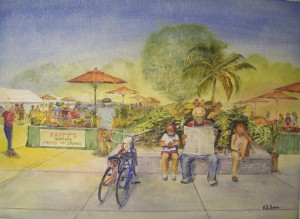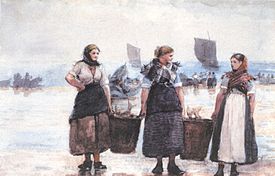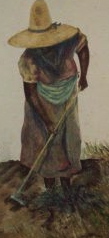
“Watercolor has an action all its own, it moves, it crawls, and it fights back.”~John Pike
Instead of using the term technique one uses when painting transparent watercolor, it should be considered tricks. It’s hard pressed for one to learn the absolute fundamentals of the craft, the reasons why watercolor behaves the way it does, and what we can do about controlling it. Remember, you can read forever about how to do something, but you learn only by doing. This is double true when painting with watercolor.
What is watercolor? Any pigment soluble in water, a type of paint made of powdered color or dye and some form of glue to form a paste that can be thinned with water.
What is transparent watercolor? Watercolor that is transparent. Enough said? However, these are unique among water based paints. Imagine different colored transparent plastic strips that when laid over each other create different colors; such as, a yellow strip over a red strip creating an orange strip. In other words the “trick” is to use a compound build up as each color underneath affects the next wash or color you put on. You actually see through all the layers of color. Learning to make it turn out exactly the way you want it is the “doing” rather than the “reading” part of the exercise. As an artist, you will make many wonderful disastrous mistakes…which some will turn out to be in your favor (which is an entirely other blog post).

The secret of painting with transparent watercolor is to learn to plan your “whites”. Remember, there is white watercolor paint, however, it usually is opaque and not transparent. A pure transparent watercolor painting does not use white, instead the artist must plan the use of white by painting around the white area leaving the white paper to be the only white. Imagine the thin line of reflective light outlining the ridge down the nose of an individual you are painting. This must be planned and painted around. In any painting there can be hundreds of reflective spots and dashes in a painting. The planning of a transparent watercolor alone is the thrill of the art.

Whatever your watercolor technique, style, or form that you wish to use is your own free choice, however your experience will always be more rewarding if not being defeated by the medium.
Once you are past the “tools of the trade,” you’ll find that painting is an endless return to nature. You’ll find new thoughts, new shapes, and new ideas.
Transparent watercolor is said to have limitations. There is the perimeter of what has already been done. A great challenge for you is to see what you can do to penetrate new and exciting territory. Good luck and have fun as you experiment with this tricky medium as it moves, crawls, and fights back.
Be sure to join our newsletter (upper right-hand side).
Check out the galleries (above).
Be sure to check out the Great Opportunities page (above)
If you want to learn more about protecting your artwork, check out the sight to the right.
Check out my Facebook page and “like” it if you do. (right)
